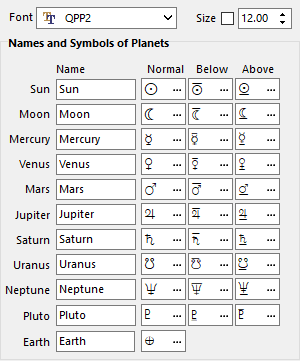Planetary tokens are used to display information about events that involve individual planets daily (planets' rising, setting and upper transit).
 | You can use the various planetary macro functions to calculate events that occur either between 2 planets (nearness), events that occur between a planet and the Sun (min/max distance), and events that occur between the Earth, the Sun, and another planet (occultation, transit, elongation, lower/upper conjunction, opposition, eclipses). |
List of Planetary Tokens
To display the times when a planet rises, sets or is in upper transit, use the following tokens, where the index X refers to the planet index as given in the table here (note that theses tokens can also be used to display times of sunrises, sunsets, moonrise and moonset, as the Sun and the Moon are treated as "regular planets" in the above table).
Some remarks:
•In the planetary tokens above, the X index referring to the "planet" are specified here.
•The planetary tokens can also be used for the Sun, the Moon, as well as more than a dozen stars and galaxies.
•By default, the above tokens are calculated for the 1st Sun Data Source of the current script. If you want to have any planetary token calculated based on another source, just append :sY to the token, where Y is a number corresponding to the Nth Sun Source of the script (ie. append :s2 to any planetary token to have it calculated based on the coordinates of the 2nd Sun Data Source of the current script).
•Use the :rnd suffix to round-off seconds (both times and angles).
If you wish to display the result of the planetary tokens above in a format that differs from the default one, you can append the suffix :fSomeFormat, which is described in more details below.
Below is a table of the default formatting in which the above tokens are generated and at the bottom of this table you will find instruction on how to tweak that formatting to match your desired result.
times (rising, setting and transit) |
By default, the times obtained from the rising, setting and transit tokens of the table above are displayed using the format hH":"NN.0 which corresponds to the hours separated from the rounded-off minutes by a colon, such as 12:38 or 5:08, for example. |
right ascension (R.A.) |
The right ascension, despite being an angle, is displayed as hours (360 degrees = 24 hours). The default format is hH"h"NN.0"m" which shows hours and minutes, such as 18h23m, for example. |
declination |
The declination angles are displayed as degrees. The default format is dD"°"NN.0"'" which shows degrees and rounded-off minutes, such as -23°01', for example. |
azimuth and altitude |
The azimuth and altitude angles are displayed as degrees. The default format is D.1"°" which shows only the degree value, with one decimal, such as 44.8°, for example. |
time offset |
The time offsets are displayed as time. The default format is +M"m"SS"s" which shows +/- minutes and seconds only, such as +10m08s, for example. |
To control the format in which the result of the planetary tokens above are displayed, you can append the :fSomeFormat suffix, using the format strings as described here. Important: the suffix :fSomeFormat must be the very last modifier of the token, so that can contain text such as ":".
Planetary Always Above or Below the Horizon

| [plXab] | Indicates by some text or symbol, whether planet X is always above or always below the horizon on the date of the token. |
The text or symbols that are to be displayed, and when, are determined by the settings specified in the Planets tab of the Moon and Sun Options scriptline property, as shown on the right.
The calculations that determine on which dates the various planets are always above or below are performed based on the geographical locations selected in the Sun Data script line property.
Here, again, by default, the above tokens are calculated for the 1st Sun Data Source of the current script. Append :sY to the token, where Y is a number corresponding to the Nth Sun Source of the script, to have it calculated based on the coordinates of the Nth Sun Data Source of the current script.
For information and events that relate to the Sun and the Moon only, see Sun tokens and Moon tokens.
See also: miscellaneous astronomical tokens and astronomical tokens calculation times.
Topic 176610, last updated on 10-Mar-2025